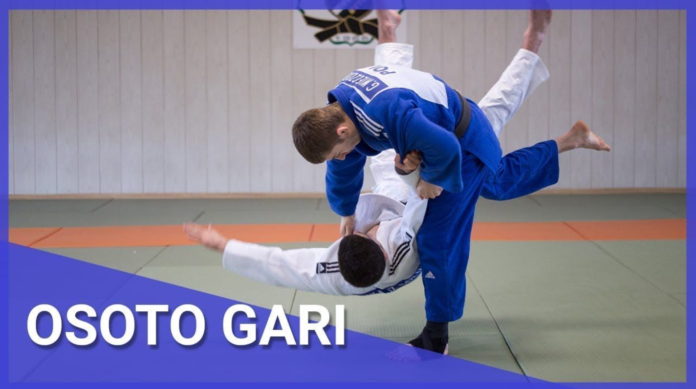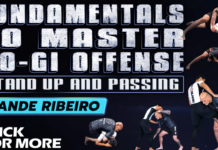
As effective and attractive as they might be, Judo throws for BJJ are not easy to master, at least when the goal is hitting them in competition against elite opposition. Simply put, Judo throws take a lot of time to master, as there are many fine details to motion and balance that are crucial for the success of the techniques. Judo throws, on the other hand, like the Osoto Gari, are simply perfect for use in Jiu-Jitsu.
Judo Fundamentals: Osoto Gari – The Outside Major Reap
The Osoto Gari, a.k.a. the Outside Major Rip or Outside Trip is one of the first things taught to Judokas. It is part of the foot sweeping techniques in Judo (Ashi Waza) and a move that is deceptively complex. It is far easier to master than hip throws and complicated motion set ups, but it will still require you to understand balance and timing.
The Osoto Gari is like a basic schoolyard fight trip – you grab a hold of the opponent’s torso step to the side and use your leg to hook their leg, pushing them over the tripping point you’ve created with your leg.
It is a bit more complex than that In Judo, of course. You’re holding a collar and sleeve grip while standing in front of the opponent. hips squared. The goal is to use the grips to off-balance the opponent, pulling them towards the leg you’re tripping and pushing them back while moving your body to the side of theirs, and using the calf of your leg to hit the calf of theirs.
The Osoto Gari works perfectly in combination with other trips and footsweeps too, but for Jiu-Jitsu purposes, mastering the really basic version is going to be all you’ll ever need to throw anyone to the ground, white belt to black.
Markings Of An Effective Outside Trip Takedown
There are plenty of technical aspects to the Osoto Gari that you’ll need to learn, especially the footwork and hand motions, but those can only come after you understand the three things that make every trip, regardless if it is from Judo, wrestling, Sambo or something you’re making up on the spot, work.
Those three things are connection, manipulating balance, and being precisely aware of timing.
Connection
The way you connect to an opponent is crucial in standing, as your hands are the first part of the body that makes contact and in most cases the only method of connecting you to the person you’re looking to throw.
The connection for an outside trip needs to provide you with the means of keeping the opponent from switching the angles in terms of hip positioning while allowing you to start moving into position for the trip. The connection is also key for disrupting balance and completing the action once the time is right to execute the trip.
Balance
Disrupting balance, or Kuzushi is one of the founding principles of the entire sport of Judo. The same applies to throwing people in all other grappling martial arts. If you want to use the Osoto Gari (or any other trip, throw, or takedown) against someone, you will have to off-balance them first, otherwise, they won’t fall to the ground.
For the purpose of tripping someone with the outside reap, you will need to make sure their weight is on the leg you’re tripping, so that once you take it away, they’ll have no choice but to fall. This is where the technical aspects of the Osoto Gari are important, including footwork, hand motions, and finishing mechanics.
Timing
The third foundational component of every Judo throw, after connection and manipulating balance, is timing. Takedowns happen as the two opponents are moving around, not from a stationary starting point. This means that you will have to be aware not just of the direction an opponent is moving in, but also if they’re lifting the leg you’re after off the ground or set it down on the ground. This is something that will take practice to really get the hang of.
How To Set Up The Osoto Gari Throw
Setting up the Osoto Gari is best described in steps, with a strong emphasis on footwork. In every step that follows, I will mention the three staples described above, thus providing the full picture in your quest to master tripping people up in Jiu-Jitsu.
Step 1
Grab the collar and sleeve of your opponent. The collar grip is at collarbone level, and the sleeve grip is behind the triceps. You want to start using the grip to off-balance your opponent immediately as you take your first step.
Step 2
If you’re going to trip the opponent’s right leg, with your left leg to the side of their right leg. The aim is to step with your left foot parallel to their right foot, right next to the opponent, on the side where you’re holding the sleeve grip.
As you step forward imagine you’re driving a huge truck and your hands are on the stirring wheel. You want to turn the stirring wheel towards the direction you’re stepping in for at least 45 degrees.
Step 3
Placing your weight on your left leg, get your right leg through in between your left leg and the opponent’s right leg. At this point, the opponent should be tilted towards the side you’re stepping in as a result of the grips. That is connection and balance all taken care of.
The moment your right leg comes in between, make sure you extend it forward so that it goes past the leg of your opponent. Your hips should be next to theirs, but facing the opposite side at this point.
Step 4
Use the calf of your right leg, which is swinging like a pendulum at this point, to strike the calf of the opponent’s right leg. Avoid trying to hook their leg at knee level as this can get you out of balance and open up counter throws.
Make sure you use the leg forward first and hit back at their calf swinging your legs backward as if you’re trying to kick behind you. As you kick back, use the arm gripping the collar to push the opponent backward, placing the fist of your gripping hand on their collar bone.
Step 5
The final part of the puzzle is staying on top after executing an Osoto Gari. To achieve this, as you feel your opponent falling after kicking their leg and pushing them backward and sideways, lift with both your palms towards your chest. This will cause the falling opponent to spin around their spine as the axis, landing them sideways.
It will also help you stay postured up and avoid getting pulled down to the mats and reversed by way of inertia.
The fact that the opponent is falling sideways means there’s also an armbar right there for the taking.
Osoto Gari No-Gi Variation For Jiu-Jitsu
For the No-Gi variation of the Osoto gari, not many changes in the way of mechanics, especially in terms of off-balancing and timing. The only slight difference is in the connection, with the collar grip being replaced by a collar tie, and the sleeve grip at the triceps level replaced by an outside biceps tie.
In Conclusion
The Osoto Gari is a very powerful trip that can be a great asset for BJJ athletes. It requires less time to drill to perfection compared to many other Judo throws and also works perfectly in No-Gi. You will need to be patient though, and give it time and reps before you figure out the exact variations that best fit your game.












































